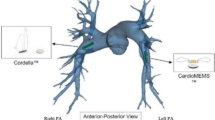Abstract
Assessment of pulmonary artery pressure is an essential element in the evaluation of children palliated with surgical aorto-pulmonary shunts prior to definitive surgical repair. We report the ease of use and accuracy of a 0.014 inch micromanometer pressure wire for the measurement of pulmonary artery pressures in children with aorto-pulmonary artery shunts. The study population consisted of 11 infants and children with either a 3.5 mm modified Blalock-Taussig shunt from the subclavian artery to the branch pulmonary artery after stage 1 Norwood repair for hypoplastic left heart syndrome or palliative staged repair for tetralogy of Fallot, or a central shunt for pulmonary atresia or double outlet right ventricle. The unique features of the micromanometer pressure wire allowed rapid access and accurate measurement of pulmonary pressures in all patients studied. We conclude that the micromanometer pressure wire is a unique and accurate alternative device for rapid and safe determinations of pulmonary artery pressures in children with aorto-pulmonary artery shunts.
Similar content being viewed by others
References
GJW Bech B De Bruyne NHJ Pijls et al. (2001) ArticleTitleFractional flow reserve to determine the appropriateness of angioplasty in moderate coronary stenosis. J Am Coll Card 103 2928–2934 Occurrence Handle1:STN:280:DC%2BD3MzkvFKisw%3D%3D
MJ Claeys JM Bosmans J Hendrix CJ Vrints (2001) ArticleTitleReliability of fractional flow reserve measurements in patients with associated microvascular dysfunction: importance of flow on translesional pressure gradient. Cathet Cardiovasc Interv 54 IssueID4 427–434 Occurrence Handle10.1002/ccd.2005 Occurrence Handle1:STN:280:DC%2BD3Mnps12ntQ%3D%3D
B De Bruyne F Hersbach NH Pijls et al. (2001) ArticleTitleAbnormal epicardial coronary resistance in patients with diffuse atherosclerosis but “normal” coronary angiography. Circulation 104 IssueID20 2401–2406 Occurrence Handle1:STN:280:DC%2BD3Mnlt12ktw%3D%3D Occurrence Handle11705815
G Gorge R Erbel S Niessing et al. (1993) ArticleTitleMiniaturized pressure guidewire: evaluation in vitro and in isolated hearts. Cathet Cardiovasc Diagn 30 IssueID4 341–347 Occurrence Handle1:STN:280:ByuC3MngsFU%3D Occurrence Handle8287466
TR Lloyd RL Donnerstein F Shirazi (1990) ArticleTitleObstruction of systemic pulmonary arterial shunts by diagnostic cardiac catheters. Am J Cardiol 66 878–880 Occurrence Handle1:STN:280:By6D383ktFc%3D Occurrence Handle2220594
Author information
Authors and Affiliations
Corresponding author
Rights and permissions
About this article
Cite this article
Everett, A., Matherne, G. Feasibility of Pulmonary Artery Pressure Measurements in Infants Through Aorto-Pulmonary Shunts Using a Micromanometer Pressure Wire . Pediatr Cardiol 24, 336–337 (2003). https://doi.org/10.1007/s00246-002-0315-0
Published:
Issue Date:
DOI: https://doi.org/10.1007/s00246-002-0315-0




